Maybe it is something to do with Katrina's appreciation of Hrithik cooking Paella on their holiday in Valencia, in the movie Zindagi Na Milegi Dubaara. But it is odd that every time someone mentions Spain, all that my mind can think of is a pan of steaming hot Paella, served beautifully by one of Valencia's famous beaches. No thoughts of bull-fights. No visions of La Sagrada Familia. And definitely not even a flash of Real Madrid. Only Paella... and the beaches.
Paella is a rice dish, akin to our Biriyani, that has its origins in the Valencian region of southeastern Spain. Often mistakenly viewed as Spain's national dish by outsiders (Given its apparent popularity, I wouldn't blame the Non-Spaniards), it is prepared in a myriad number of ways, the most common ones being the Valencian Paella, the Seafood Paella, and the Mixed Paella. The dish derives it's name from the French word paelle (or the Spanish word paellera), meaning 'pan'; in reference to the special shallow pans that are used in its preparation. Traditionally, the dish is served directly from the paellera, and guests enjoy it with a number of side offerings. The use of these paelleras ensures that the bottom layer of rice is subtly toasted in the cooking process. This layer of semi-burnt toasted rice, locally called socarrat, is considered be a delicacy in it's own right and is essential for a good Paella. It reminds me of the days when we used to fight for the burnt-rice leftover at the bottom of the Biriyani pan. Deliciousness!
A special ingredient required for Paella is the short grained Spanish Bomba rice; something that I have not been able to find in the aisles of my local supermarket. However, last Friday, a friend had taken me to Trader Joe's and I could hardly contain my joy when I saw a packet of Arborio on their shelves. While Arborio is technically Italian and is not the traditional rice used for making Paella, it is known to be an excellent substitute. And more importantly, since I did not want to put off the making of the dish any more, citing lack of ingredients as an excuse, I came home armed with some fine virgin olive oil, a pack of Arborio, and lots of vegetables, fully prepared for the culinary-experiment the next day. In the recipe for Spicy Vegetable Paella that follows, I have replaced the meat used in traditional Paella with vegetables and also added some additional spices to take it a notch higher on the zestiness index. And of course it was awesome. Está delicioso!
PAELLA dE PICANTE VERDURAS (Serves 3)
Set-up Time : 20 minutes
Set-up Time : 20 minutes
Experiment Run-Time : 45 minutes
The Shopping List
Set 1: At the Chopping Board
Onion : 1 Large, sliced thinly
Red Pepper : 1, sliced into thick strips
Mushrooms : 4-5, cut along its length
Green Chilies : 3 slit along its length
Garlic : 2 cloves, minced
Carrots : 1, julienned
Tomato : 1 Large, finely chopped
Frozen Peas : 1/2 cup
Frozen Broccoli : 1/2 cup
Onion : 1 Large, sliced thinly
Red Pepper : 1, sliced into thick strips
Mushrooms : 4-5, cut along its length
Green Chilies : 3 slit along its length
Garlic : 2 cloves, minced
Carrots : 1, julienned
Tomato : 1 Large, finely chopped
Frozen Peas : 1/2 cup
Frozen Broccoli : 1/2 cup
Set 2: From the Spice Rack
Saffron : 1tsp, crushed
Crushed Red Pepper : 1 Tbsp
Crushed Red Pepper : 1 Tbsp
Salt : as required
Pepper : 1 tsp
Set 3: Everything Else
Arborio/Bomba/Calasparra : 1 Cup
Vegetable stock : 2 cups
Warm water : 1 cup
Virgin Olive Oil : 1 Tbsp
Equipments
A shallow pan, preferably heavy
Vegetable stock : 2 cups
Warm water : 1 cup
Virgin Olive Oil : 1 Tbsp
Equipments
A shallow pan, preferably heavy
Methodology
1. Heat the olive oil in the pan, and add the onions, minced garlic, green chilies and the sliced red peppers from Set 1. Sauté the vegetables with a pinch of salt and the crushed red peppers from Set 3, until the onions begin to turn brown in caramelization.
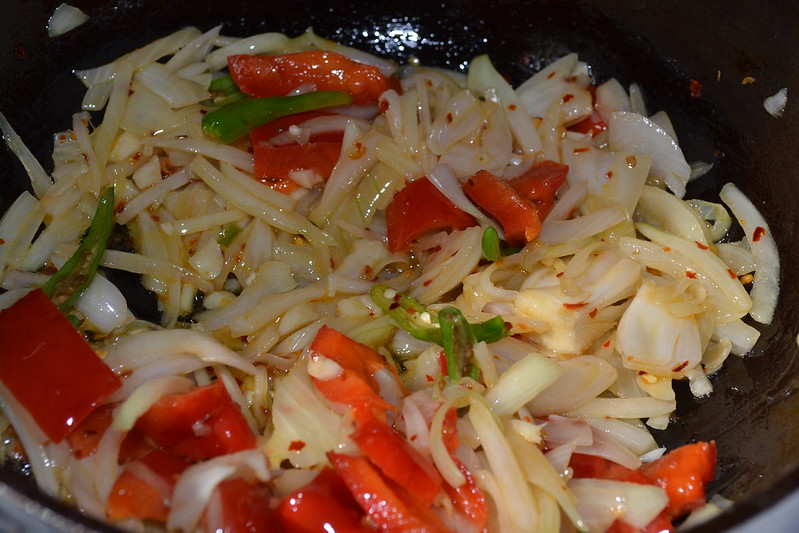
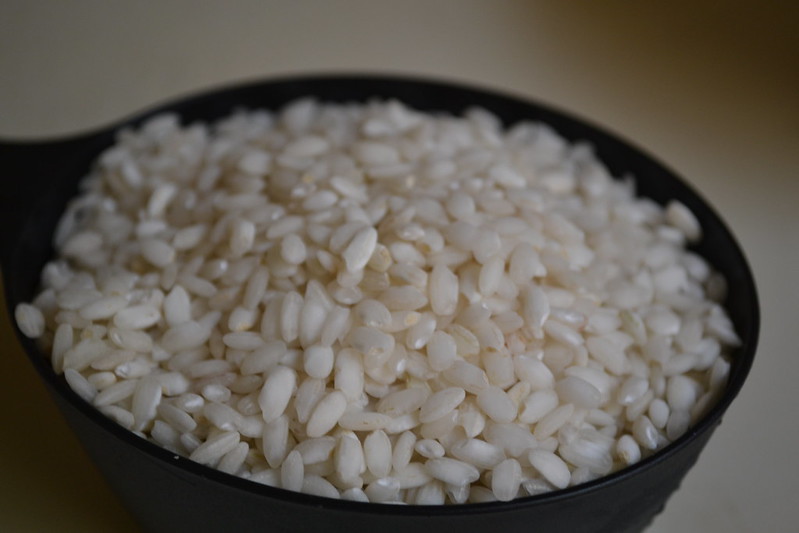
3. Add the vegetable stock from Set 3, along with a cup of warm water, the mushrooms, and the chopped tomatoes, to the rice-vegetable mixture.
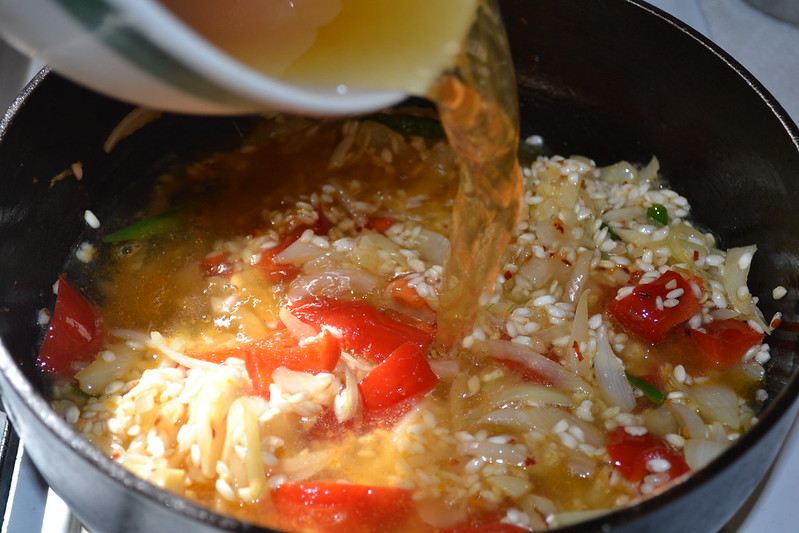
4. When the stock comes to a gentle boil, crush the saffron strands between your fingers and add it to the merrily boiling dish. This is also where you add any additional salt. Depending on the sodium content in the stock, it maybe necessary to adjust the salt to your tastes. Cover the pan with a lid and let the rice cook for about 25 minutes.
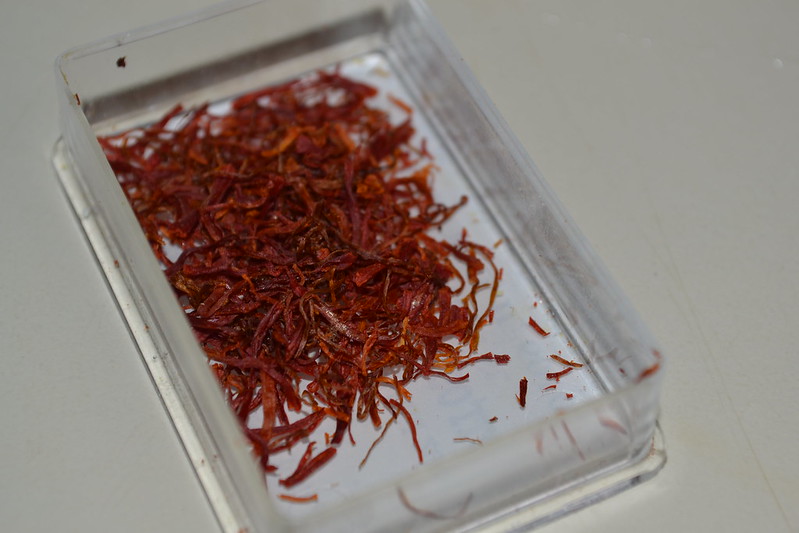
5. Open the pan and add the carrots, broccoli, and peas to the nearly-cooked rice. Also add half-a-cup of water if the rice looks dry. Cover the pan once again and allow the added vegetables to cook for an additional 10-15 minutes.
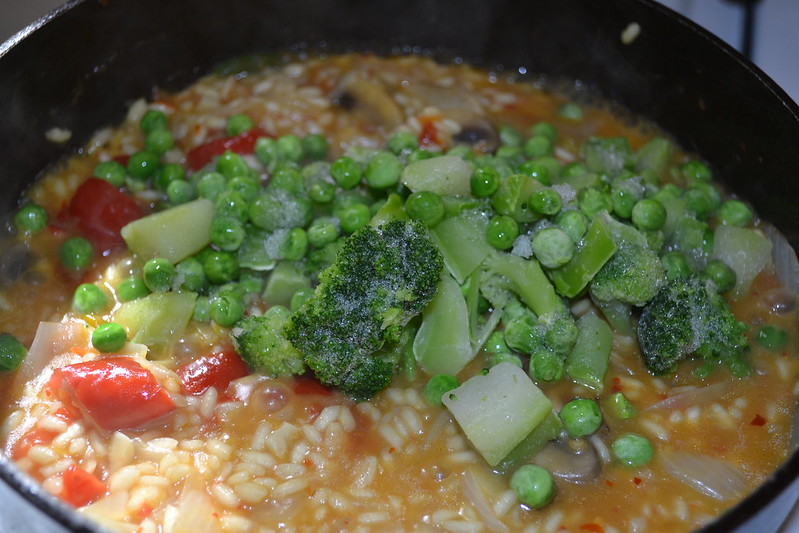
6. Open the pan one last time to check if the rice is done. Do not stir the rice, as it may dislodge the layer of socarrat at the bottom. If done to satisfaction, take the pan off the heat and allow to sit covered for about 20 minutes. This provides ample time for the rice to absorb any of the remaining broth and adds additional flavor to the rice.
7. Serve directly from the pan. You may also sprinkle a little pepper onto individual servings for an added zest.
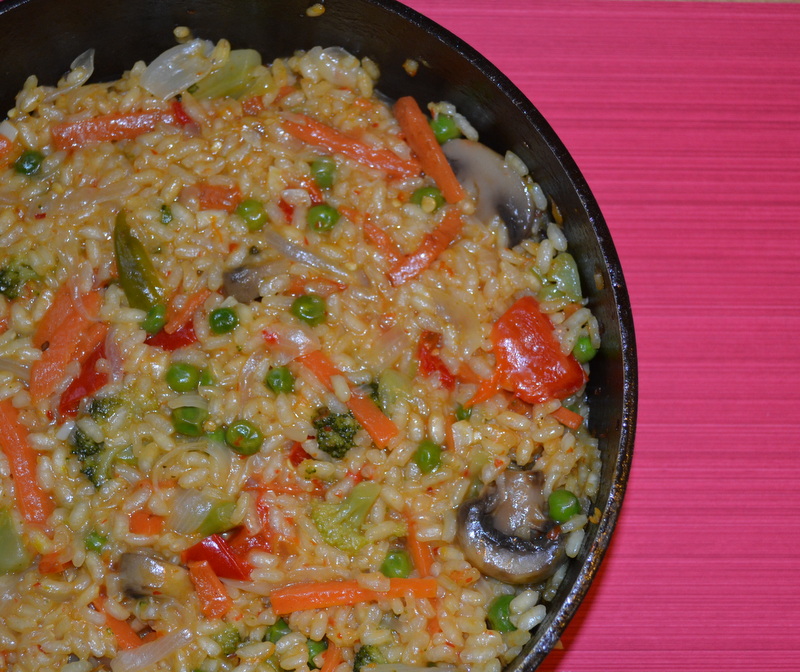
Paella is usually served with a simple tossed salad and a dash of olive oil and pepper on top. I had it plain, in all its original glory. In the beginning it tasted like a starchy version of our pulao, but with every spoon, I realized the uniqueness of the dish; from the slightly chewy rice grains and a strong saffron flavor to the additional taste of the vegetable stock and the little socarrat that I was lucky to get. And the best part was that I liked more when it had gone cold from all the time that I had taken for the photo-session. I am so inspired that I have already planned to try the Seafood Paella with the rest of the Arborio rice. Here's to the Spaniards for some kick-ass contribution to Gastronomy. Viva La Paella!

2. Add a cup of the chosen rice to the sautéd vegetables and coat the vegetables with the rice grains.

3. Add the vegetable stock from Set 3, along with a cup of warm water, the mushrooms, and the chopped tomatoes, to the rice-vegetable mixture.

4. When the stock comes to a gentle boil, crush the saffron strands between your fingers and add it to the merrily boiling dish. This is also where you add any additional salt. Depending on the sodium content in the stock, it maybe necessary to adjust the salt to your tastes. Cover the pan with a lid and let the rice cook for about 25 minutes.

5. Open the pan and add the carrots, broccoli, and peas to the nearly-cooked rice. Also add half-a-cup of water if the rice looks dry. Cover the pan once again and allow the added vegetables to cook for an additional 10-15 minutes.

6. Open the pan one last time to check if the rice is done. Do not stir the rice, as it may dislodge the layer of socarrat at the bottom. If done to satisfaction, take the pan off the heat and allow to sit covered for about 20 minutes. This provides ample time for the rice to absorb any of the remaining broth and adds additional flavor to the rice.
7. Serve directly from the pan. You may also sprinkle a little pepper onto individual servings for an added zest.

Paella is usually served with a simple tossed salad and a dash of olive oil and pepper on top. I had it plain, in all its original glory. In the beginning it tasted like a starchy version of our pulao, but with every spoon, I realized the uniqueness of the dish; from the slightly chewy rice grains and a strong saffron flavor to the additional taste of the vegetable stock and the little socarrat that I was lucky to get. And the best part was that I liked more when it had gone cold from all the time that I had taken for the photo-session. I am so inspired that I have already planned to try the Seafood Paella with the rest of the Arborio rice. Here's to the Spaniards for some kick-ass contribution to Gastronomy. Viva La Paella!


